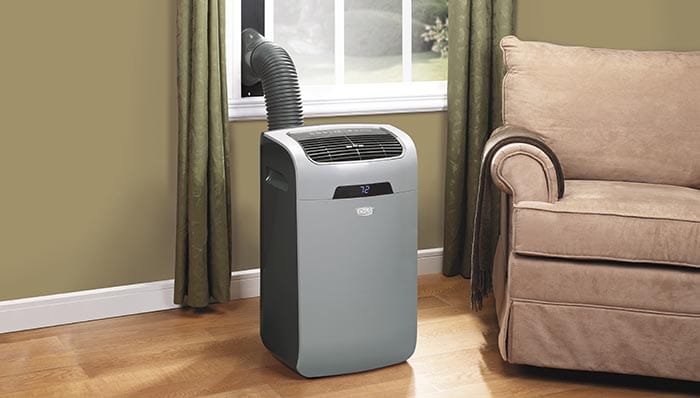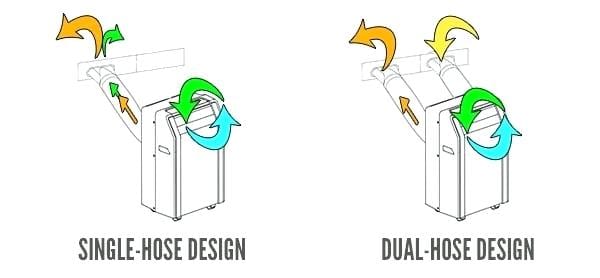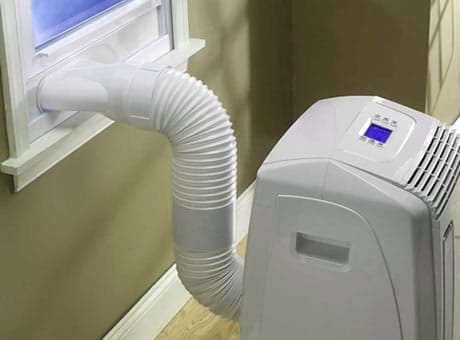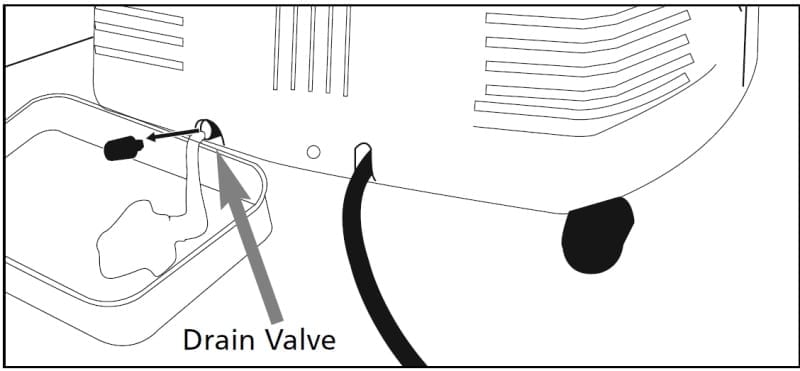Do you need to endure a hot summer in a house that doesn’t have central air conditioning?
A portable air conditioner may be just the appliance you need if you want to cool your room effectively. Without worrying about window units and venting.
Many apartments may not allow window air conditioners due to design restrictions, but portable air conditioners can do the job as long as you can vent the hot air. Let’s check out what makes portable units attractive for cooling a room, and also look at the best models available.
At a Glance: Our Top Picks for Portable AC Units
- OUR TOP PICK: Della 14000 BTU
- BEST BUDGET OPTION: Black+Decker BPACT14WT, 14000 BTU Portable Air Conditioner
- EDITOR'S PICK: Emerson Quiet Kool EAPC14RD1 Portable Air Conditioner
Comparison of the Best Portable AC Units
| IMAGE | PRODUCT | |
|---|---|---|
Our Top Pick  |
| View Latest Price → |
Best Budget Option  |
| View Latest Price → |
 |
| View Latest Price → |
Does a Portable AC Really Work?
You may be wondering if a portable unit is really efficient. The answer to that is yes, it certainly is if you use it for the intended purpose. A portable AC will work for small, medium and large sized rooms, based on its BTU power.
It will require warm air to be vented outside to be effective, and the condensate will need to be drained. They come in a range of capacities that can handle residential, commercial and industrial requirements.
A Portable AC can cool a room as effectively as a window unit, as long as it is well vented.

Portable AC in a room (Source)
What to Look For When Buying a Portable AC Unit
There is a wide variety of different options available for you to choose from. However, before making your purchase, you need to consider a few factors. We’ve listed down a few factors that you need to consider that make these portable air conditioners a good option for you.
Cooling Power
You need to consider the cooling power of the unit. If the unit doesn’t provide you with the right cooling power for your room size, then the air conditioner will be of no use to you. To make sure that you’re purchasing the right unit, you need to look at the BTU rating of the cooling unit. This rating helps to measure the cooling power of the air conditioner.
Now, if you want an air cooling unit for a smaller room, then a unit offering 8000 BTUs would be a good option. But if you want an air cooling unit for your living room or any room that is of 600 sq. ft., then an air conditioner offering 14000 BTUs is more suitable for you.
Noise Level
You will also need to consider a unit that has a low noise level. Also, it is better to opt for an option that is both cost-effective and has features that allow it to save energy.
One Hose vs. Two Hose Units



Diagram of a one and dual hose portable AC (Source)
Single hose portable units are inefficient in cooling the room. Because the air that is sent out of the hose is the air from the inside of the room that has been dehumidified. Energy is wasted to dehumidify and cool the incoming air.
However portable AC models that possess two hoses to direct the warm and cooled air to proper locations are much more efficient. They behave much more like traditional window air conditioners. The air is drawn into the unit through the intake, where it is cooled and then sent back into the area.
The unit heats up through the cooling process, and the intake hose pulls air from outside the home to cool the air conditioner down. A second hose sends all of the warmed air outside of the home. With this efficient exchange of air, the dual hose system doesn’t have to work nearly as hard as the single hose option.
Dual hose systems may require a little more work to set up. But they are generally easy-to-install and require no additional maintenance.
Key Terms to Know
To help compare products in this review, we have included a few key specifications for each. Here is a quick summary of what they mean.
- BTUs: British Thermal Unit (BTU) measures energy. This refers to the energy necessary to increase the temperature of one pound of water by one degree Fahrenheit.
- Dimensions: The actual dimensions in l x w x h.
- Weight: The physical weight of the air conditioner.
- Voltage: The amount of electricity the unit uses. This determines the type of outlet it must plug into.
- Coverage Area: The amount of square footage the unit can adequately cool, determined by the manufacturer.
- dB (decibel) Level: The amount of noise the AC produces when in operation.
- Modes: The modes of operation the unit features. This includes dehumidification, fan only, cooling, etc.
Reviews of the Best Portable AC Units
To buy a good portable unit, you must consider its functionality, price and the cooling requirements in your home or office.
Best Overall:
Della 14000 BTU

PROS
CONS
What Recent Buyers Report
Users report that this is a very aesthetically pleasing portable air conditioner. It cools the room down quickly and efficiently. This air conditioner model offers silent operation. It comes with a remote that you can use to control its function.
It features wheels that allow you to move around the house without any difficulty. This portable air conditioner is definitely worth considering.
Why it Stands Out to Us
This is a great portable AC option for you to consider. It is a multi-functional unit that can be used for both cooling and heating purpose. The dehumidifier feature allows it to prevent bacteria and mold from growing in your house.
You don’t have to worry about having to drain the unit; it features self-evaporation technology that does that for you. All in all, this entire cooling unit provides you with quite a lot of features that you can enjoy on a hot day.
Who Will Use This Most
We find this to be a great option for you if your house has inconvenient windows that are either too small or too high. These portable air conditioners are a great option if your condo or apartment rules do not allow you to change your house exterior.
If you live in a humid area, then this unit can help in dehumidifying your space to make it more comfortable for you to sleep. Lastly, if you’re looking for a cost-effective air conditioner, then this is a good option to consider.
Bottom Line
Overall, this model is convenient for many homeowners and renters. It is an affordable option that allows you to make your rooms cool. You can easily transport it from one room to another. It helps in dealing with the humid climate by dehumidifying your room and making it easier for you. It is definitely an option you should consider.
Product Specs
BTUs:
14,000
Dimensions:
16 x 13.5 x 29"
Weight:
79.2 lbs
Power Consumption:
115V
Coverage Area:
700 sq. ft
dB (decibel) Level:
49-52 dBA
Modes:
Cool, Dry, Fan
Hose Length:
8 ft
Best for the Money:
Black+Decker BPACT14WT, 14000 BTU Portable Air Conditioner

This 14,000 BTU AC can cool an area of around 300-350 square feet. The key features include a LED digital display, a 24 hour on/off timer and sleep mode. The 3 operation modes and the bucketless designed cooling unit offer quiet cooling, fan and dehumidification modes.
The filter can be removed and rinsed under a faucet. Vertical motion creates a steady and powerful airflow that provides a consistent temperature in any room in the house. A slide-out filter rinses easily under a faucet for a fresh air feel. The unit can be moved on its 4 caster wheels.
The included installation materials are the exhaust hose and window kit, plus a manual guide for set up.
Product Specs
BTUs:
14,000
Dimensions:
17.1 x 13.8 x 28.1"
Weight:
68.3 lbs
Power Consumption:
115V / 1430 W
Coverage Area:
350 sq. ft
dB (decibel) Level:
High: 53 dB; Sleep: 51 dB
Modes:
Cool, Fan, Dehumidifier
Hose Diameter:
5 in
Hose Length:
4 ft. 11 in
Editor's Pick:
Emerson Quiet Kool EAPC14RD1 Portable Air Conditioner

This 14000 BTU (ASHRAE-128 Standard) / 7800 BTU (DOE 2017 Standard) portable air conditioner is designed to cool a room of up to 350 sq. ft.
It comes with features like remote control, 24-hour on/off timer, and sleep mode. It uses auto evaporation technology to reduce unwanted moisture in the air without any drainage necessary.
Installation is easy with the included window venting kit.
The unit can be installed anywhere.
Product Specs
BTUs:
14,000
Dimensions:
17.51 x 14.76 x 28.34"
Weight:
68.3 lbs
Power Consumption:
115V
Coverage Area:
350 sq. ft
dB (decibel) Level:
54 dBA
Modes:
Cool, Heat, Dry, Fan
Hose Diameter:
5 in
Hose Length:
5 ft
4. Honeywell MN12CES Portable Air Conditioner

The 12,000 BTU portable air conditioner from Honeywell can cool areas up to 450 sq. ft.
It is equipped with a digital LED display, precise touch controls, and remote control.
The AC has 3 operating speeds and an automatic on/off timer for up to 24 hours. It is quiet and powerful, offering optimum cooling, dehumidification and fresh ventilation in a sleek package.
The AC comes with everything needed for installation, including a hose and a window venting kit.
The unit can be moved easily on caster wheels.
Product Specs
BTUs:
12,000
Dimensions:
15.7 x 16.5 x 29.3"
Weight:
68.3 lbs
Power Consumption:
115V / 1.4 kW
Coverage Area:
550 sq. ft
dB (decibel) Level:
High: 54 dB; Low: 51 dB
Modes:
Cool, Dry, Fan
Hose Diameter:
5 in
Hose Length:
4 ft
5. Whynter ARC-142BX 14000 BTU Portable Air Conditioner

This 14,000 BTU AC has 4 operational modes: Auto, Air conditioner, Fan or Dehumidifier. It uses the CFC free GREEN R-410A refrigerant as well as advanced self-evaporating technology, to recycle moisture collected during the cooling process. To produce cool air and minimize condensate build-up.
The unit has an auto-restart function to restore the previous settings after a power outage, and a 24hr timer to activate or shut-off. The air is cleaned by a washable Pre-Filter and an Activated Carbon Filter. The unit is recommended for spaces up to a 500 sq. ft.
The noise level is 53 dBA, and the included installation kit contains a plastic exhaust hose and a plastic window kit.
Product Specs
BTUs:
14,000
Dimensions:
28 x 15 x 18"
Weight:
86 lbs
Power Consumption:
115V / 1480 W
Coverage Area:
500 sq. ft
dB (decibel) Level:
< 53 dB
Modes:
Cool, Fan, Dehumidifier
Hose Length:
59" (Exhaust)
6. EdgeStar AP12000S Portable Air Conditioner

The 12,000 BTU (ASHRAE-128 Standard) / 5,500 BTU (DOE 2017 Standard) can cool up to 425 Square Feet and has 3 fan speeds. It contains a washable pre-filter and one replaceable carbon filter.
The adjustable digital thermostat allows a 61-89 F temp range and can be controlled through remote control. It comes with caster wheels for mobility and has a high 10.0 EER (Energy Efficiency Ratio). It makes use of R410A CFC free refrigerant, so it is environmentally friendly.
For setting up the unit, an exhaust hose and window kit are included.
Product Specs
BTUs:
12,000
Dimensions:
15 x 17.25 x 31"
Weight:
69 lbs
Power Consumption:
115 / 950 W
Coverage Area:
425 sq. ft
dB (decibel) Level:
High: 54 dB; Low: 52 dB
Modes:
Cool, Dry, Fan
Hose Diameter:
5 in
Hose Length:
49" (Exhaust)
Advantages of a Portable AC Unit
Choosing a portable unit has many advantages over window units or mini split ACs. Firstly, you don’t have to pay for expensive installation, it is quick and simple enough to do yourself. Almost all portable ACs come with window installation kits to help you vent the warm air outside.
Secondly, they are easy to reposition and move around within your home. So you can cool the room you want, without cooling extra rooms. This is particularly useful for apartments which have air-conditioning in some rooms, but not in others. It also helps for events where air-conditioning is needed for a few days, but not on a permanent basis.
Unlike traditional window units, portable units allow you to make full use of your window, giving you an unobstructed view. Except for a small area for venting out the warm air, in case you will be using the window to vent. If natural light or views are important for you, this can be a strong factor.
One of the biggest advantages of portable ACs is that they require minimal installation and can be moved from room to room as needed. This means less inconvenience to set up. And you only have to cool the room you want to, which cuts down on electricity bills.
Portable ACs are also an excellent option for RVs or campers. As well as for recreational homes without air conditioners.
Disadvantages of a Portable AC Unit
Along with their pros, portable units also have some cons. They are typically noisier than window units because portable units are located entirely inside the room. Whereas the window unit noisiest part is located outside.
Secondly, these units do have placement restrictions, due to the need for venting warm air and draining condensate. So they can’t be just placed anywhere, but need to be located near a vent or window, as well as a power outlet for power.
Some units come with condensate pans that fill up with water that is removed from the air, during the dehumidification process. Since it is an integral part of the air conditioning process, this cannot be avoided. Although some of the newer models have an auto-evaporation technology that bypasses this. It can be a bother to have to drain the pan when it fills up.
Venting Your Portable AC Unit
All portable ACs must be vented correctly to function properly. Venting the warm air allows efficient cooling, as the temperature within your room is lowered, while the excess heat is dumped outside. Operating the AC without proper venting won’t work, it will just increase the temperature of your room! The warm air can be vented anywhere outside, whether through the window or a vent. It can even be vented into other rooms if you don’t care about heating them a little.



Portable Air Conditioner Window Venting Kit (Source)
You may be wondering how easy it is to install the AC. Don’t worry! It’s usually very quick and easy-to-install the venting. And a standard window kit that comes with the AC includes a window bracket, one or two vent hoses, and the vent hose adapters. The average vent hose extends 4 to 5 feet, so you need to install yours close to a window.
Here is a Step-by-Step Guide to Set up Your Portable AC
1. Attach any hose connectors/adapters and insert the hose (or hoses).
2. Extend the adjustable window kit to the length of your window. If necessary, trim the window bracket to fit your window snugly. Your specific model may come with screws to keep the window kit in place. Then close your window to secure the kit in place.
3. Connect the vent hose to the window kit.
4. Once your unit is properly installed and vented, just plug it in and program your settings. Now you’re all set.
Draining the Condensate



Draining portable AC (Source)
Like all air conditioners, portable units also draw moisture from the air and dehumidify it. The water or condensate needs to go somewhere, and there are three ways the units can handle it.
Fully Evaporative
With the newer models, the fully evaporative technology allows ACs to do away with condensate reservoirs or buckets. This means you'll never have to deal with the collected condensate water. These are popular models thanks to the convenience and continuous operation.
Gravity Drain with Condensate Pump
Another option for portable models is a gravity drain. You simply attach a hose to the drain port and direct water into a drain or another location. This option means you need to figure out where the water should go, such as out the window or into a drain.
Buckets to be Emptied
Most standard portable air conditioners have buckets or reservoirs that need to be emptied periodically. Depending on your humidity and time of use, the frequency may vary from every 8 hours to once a month. The condensate will collect inside the unit. And you'll simply have to turn it off, empty the bucket, and then replace it before cooling starts again. Most units have an auto-switch that turns off the unit once the water reaches a certain limit for safety.
Care and Maintenance
To keep your portable AC in top working condition, some regular maintenance will be very useful. Make sure that you place the unit in a place that is free from dust and dirt – this will prevent your AC motor from getting clogged or dirty. Clean the filter often, and ensure that the carbon filter is replaced every 4-6 months.
Clean the rear vents with a vacuum brush attachment occasionally. Also, clean the exterior of the unit occasionally, and keep it out of direct sunlight to protect the surface and finish. Ventilation and drainage are both important. Ensure that the exhaust hoses are straight and don’t have any kinks in them.
To clean the condenser coils, you can use a spray of a mixture of water and lemon juice or vinegar.
Conclusion
A portable AC unit can be one of the most useful appliances in your home. Especially when you are facing the humid summer heat without any ACs. It can preserve your window view and let in natural daylight while saving utility costs by keeping only one room cool at a time.
If you are looking for the best model for your needs, consult the list we’ve compiled above. Learn the tips you need to keep your AC unit in top condition, and it will reward you the care with years of uninterrupted service.
People Also Ask
Since summer is right around the corner, you need to consider how you’ll be able to keep the hot air and humidity from ruining your time. This is why you need to invest in a cooling unit to make your life a whole lot easier.
But before you make your purchase, you must have questions that you want answers to. Well, we have compiled some basic things that most people wish they knew before they made their purchase.
Are Portable AC Units Any Good?
The good thing about using a portable air conditioner is that you won’t have to block your window, especially if it’s the only source of natural light in your apartment. With these portable air conditioners, you have the flexibility of being able to choose where you want the unit to be.
Moreover, with this cooling unit, you don’t have to worry about the whole installation process. All you have to do is simply fit the exhaust hose in its place with the window and then simply plug the unit in. Voila! It’s ready to be used.
Is a Portable AC Better Than a Window Unit?
The thing about portable air conditioning units is that they are very easy to install compared to a window AC, whereas with a window AC, you don’t have to worry about the unit taking up space in your room.
The majority of the time, homeowners’ associations do not allow people to use window units as they hang outside the window. Now with a portable AC unit, you don’t have to worry about that.
A portable unit offers you mobility; you can move it from room to room. While there are some benefits of using a portable AC unit, at the end of the day, it really does depend on your preference and requirements. Both the AC do their jobs well; it’s mainly the one you prefer that matters.
How Long Do Portable AC Units Last?
The lifespan of an air conditioner depends on various factors, such as how often you use your air conditioner, how well you maintain your cooling unit, etc. Usually, you can expect an air conditioner to last about 10 to 15 years.
Cooling units that are often neglected and are used more frequently can last up to 10 years. However, with moderate usage, they can be expected to last for at least 20 years. If properly maintained, you can expect your cooling unit to last 20 to 25 years.
Can You Use a Portable Air Conditioner in a Room With no Windows?
One of the most common questions is if it’s possible to use a portable air conditioner in a room that doesn’t have a window. And the answer is yes, you can. You can use an air conditioner to cool a room without a window; all that you will have to do is vent your AC so that it performs well.
Does a Portable AC Need to be Vented?
You need to understand that even portable air conditioners release a hot stream of fumes. This is one thing that happens inside the engine; hence a lot of people are unaware.
Apart from that, even the room temperature air makes its way into the unit through the registration process. This way, the warm room temperature air gets trapped through the cooling radiator. This causes the blower to emit hot air back into the room, which beats the purpose of having an AC in the first place. Hence, it is important to vent hot air.
Related Portable AC Guides
Here are some related guides we have that you may be interested in:


